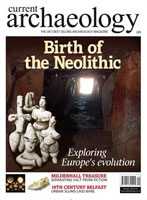This month we begin the first of a three part series based on Barry Cunliffe’s comprehensive study of the archaeology of Europe – Europe Between the Oceans. Then onto the mystery and intrigue that surrounds the discovery of one of the richest treasures ever found in Britain, The Mildenhall Treasure. The enigmatic Dark Ages have long been shrouded in fantasy and legend: could scrutiny of those historical sources reveal a more prosaic truth? There was nothing fantastic about life in the 19th century slums of Belfast, as recent excavations in the city clearly show.
The Conference Report presents a snapshot of the Archaeology Festival 2009 as well as a round-up of the winners of the first ever Current Archaeology Awards.
The Land Between the Oceans: Part 1
What is so special about Europe that it came to dominate the world? Barry Cunliffe has deservedly earned himself a formidable reputation for pulling together a mass of information and then presenting it in a panoramic overview of the past. In his latest book, Europe Between the Oceans, he examines the archaeology of Europe from 9,000 BC-AD 1000. In the first of our three part series, we look at the ‘Neolithic Revolution’ when the change in climate and environment made its impact on the foraging habits of Paleolithic hunter-gathers.
The Mildenhall Treasure
The dazzling collection of Late Roman silverware, discovered in the small village of West Row in Suffolk just after the Second World War, is one of the richest hoards ever found in Britain. Yet, even 60 years later, mystery and intrigue surround the manner of its discovery. Accusations and counter-accusations dogged the investigations at the time – and its story inspired Roald Dahl to write a children’s book called The Mildhenhall Treasure. Now, Richard Hobbs from the British Museum has decided to do a little digging of his own to unravel the truth behind the story.
Excavating the Slums of Belfast
From rural landscape to urban squalor in just 200 years, Belfast’s 19th century city slums were a festering swamp of overcrowded, grim and neglected housing. Described in 1853 as an ‘immense mass of human wretchedness and vice’, this deprived area of the city was the result of rapid expansion and radical industrialisation throughout the 18th and 19th centuries. With plans to redevelop the area, recent excavations have been undertaken that trace the rise of these urban slums, revealing just how grim life was for some of the city’s poorest inhabitants.
Rewriting the Age of Arthur
The obscure history of Britain’s 5th and 6th centuries, known as the Dark Ages, is derived from the oral tradition of story-telling. Could it be that when these tales of heroic deeds against invading foes were actually written down, they were subjected to a little 9th century Anglo-Saxon spin?

